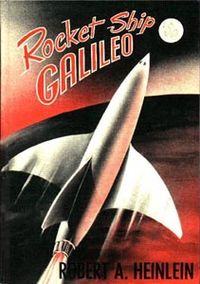Rocket Ship Galileo
by Robert A. Heinlein
After World War II, three teenage boy rocket experimenters are recruited by one boy's uncle, Dr. Cargraves, a renowned physicist who had worked on the Manhattan Project, to refit a conventionally powered surplus "mail rocket". It is to be converted to run on a thorium nuclear pile which boils zinc as a propellant. They use a cleared area in a military weapons test range in the desert for their work, despite prying and sabotage attempts by unknown agents.
Upon completion of the modifications, they stock the rocket, which they name the Galileo, and take off for the Moon, taking approximately three days to arrive. After establishing a semi-permanent structure based on a Quonset hut, they claim the Moon on behalf of the United Nations.
As they set up a radio to communicate with the Earth they pick up a local transmission, the sender of which promises to meet them. Instead, their ship is bombed. However, they are able to hole up undetected in their hut and succeed in ambushing the other ship when it lands, capturing the pilot. They discover that there is a Nazi base on the Moon. They bomb it from their captured ship and land. One survivor is found, revived, and questioned.
The boys also find evidence of an ancient lunar civilization, and postulate that the craters of the Moon were formed not by impacts from space, but by nuclear bombs that destroyed the alien race.
When the base's Nazi leader shoots the pilot in order to silence him, Cargraves convenes a trial and finds him guilty of murder. Cargraves prepares to execute the prisoner by ejecting him into vacuum, mostly as a bluff for information on how to fly the base's spaceship. The Nazi capitulates in the airlock and teaches them how to fly the ship back to Earth.
The boys radio the location of the hidden Nazi base on Earth to the authorities, leading to its destruction; they return as heroes.
